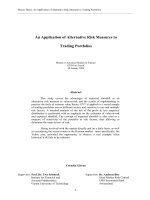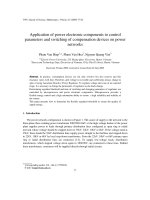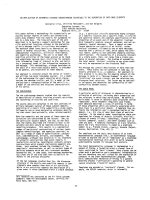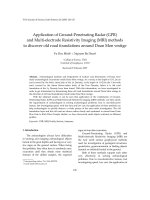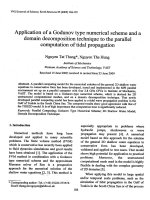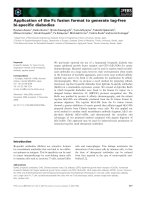application of statistical moment method to thermodynamic properties of metals at high pressures
Bạn đang xem bản rút gọn của tài liệu. Xem và tải ngay bản đầy đủ của tài liệu tại đây (204.72 KB, 9 trang )
<span class='text_page_counter'>(1)</span><div class='page_container' data-page=1>
Vol. 69, No. 7, July, 2000, pp. 2067-2075
Application of Statistical Moment Method to Thermodynamic
Properties of Metals at High Pressures
Vu Van Hung∗ and Kinichi Masuda-Jindo
Department of Materials Science and Engineering, Tokyo Institute of Technology,
Nagatsuta, Midori-ku, Yokohama 226-8503
(Received September 16, 1999)
The moment method in statistical dynamics is used to study the thermodynamic properties
of metals taking into account the anharmonicity effects of the lattice vibrations and hydrostatic
pressures. The explicit expressions of the lattice constant, thermal expansion coefficient, and
the specific heats Cv and Cp of cubic (fcc) metals are derived within the fourth order moment
approximation. The thermodynamic quantities of Al, Au, Ag, Cu, and Pt metals are calculated
as a function of the pressure, and they are in good agreement with the corresponding
exper-imental results. The effective pair potentials work well for the calculations of transition and
noble metals, compared to those of the sp-valence metals. For obtaining better agreement of the
thermodynamic quantities of metals like Al, it is required at least to use the more sophisticated
electronic many body potentials. In general, it has been shown that the anharmonicity effects
of lattice vibration play a dominant role in determining the thermodynamic properties of metals
under high pressures and at the finite (high) temperatures.
KEYWORDS: anharmonic effect, lattice vibration, moment method, hydrostatic pressure, compressiblity, specific
heat, Grăuneisen constant
Đ1. Introduction
The thermodynamic properties of materials at high
pressures are of great interest not only from a
funda-mental point of view but also for technological
applica-tions.1, 2) <sub>One of the interesting problems is the </sub>
pres-sure induced structural transformations.3-9) The
cohe-sive mechanisms and structural properties of a wide
va-riety of materials have been studied for last two decades
using the first principles density functional theories.4-7)
In general, the first principles theory has been very
suc-cessful in predicting the ground-state properties, such as
crystal structure and atomic volume of the crystalline
materials. Calculations show that some materials
un-dergo crystallographic phase transition upon
compres-sion of the Mbar order and at low temperature region.
It is also known that the effects of pressure on the gap
properties of the semiconducting alloys like AlxGa1<sub>−x</sub>As
are of great importance and special attention has been
given to the direct-to-indirect gap transitions.10)
In order to understand the pressure dependence of the
thermodynamic properties of materials, it is highly
de-sirable to establish an analytical method which enables
us to evaluate the free energy of the system taking into
account both the anharmonicity and quantum
mechan-ical effect of the lattice vibration. So far, the
numeri-cal numeri-calculation methods, such as the molecular dynamics
and Monte Carlo simulation techniques have been
pre-sented. However, it is generally difficult to get simple
algebraic formula between the thermodynamic
quanti-ties and physical insight of the phenomena, within the
∗<sub>Permanent address: Hanoi National Pedagogic University, km8</sub>
Hanoi-Sontay Highway, Hanoi, Vietnam.
2067
non-analytical numerical simulation studies.
The phase transformation as a function of pressure can
be studied by calculating the Gibbs free energies of the
competing phases, although we do not go into details of
the phase transitions in the present study. In order to
in-vestigate the thermodynamic properties of the materials,
as a function of the pressure, we use the moment method
in the statistical dynamics11-13) and derive the explicit
expressions of the free energies of the system. In
par-ticular, the thermodynamic properties of face-centered
cubic (fcc) metals are investigated within the fourth
or-der moment approximation of the atomic displacements.
The nearest-neighbour distance, thermal expansion
co-efficient, and specific heats Cv and Cp of cubic metals
are derived in terms of the hydrostatic pressure P and
the temperature T . The numerical calculations are
per-formed for fcc Al, Au, Ag, Cu and Pt metals, using the
effective pair potentials between the atoms. For
compari-son, we have also used the many body potentials derived
from the microscopic electronic theory. We will show
that the theoretical calculations on the thermodynamic
properties in good agreement with the corresponding
experimental results. Here, we note that the present
the-ory can be applied straightforwardly to study the
ther-modynamic properties of metals having lattice structures
other than the fcc structure and also to materials having
no crystallographic symmetry.
In the present article, we study the pressure
depen-dence of the thermodynamic properties of the fcc metals,
going beyond the harmonic approximation of the lattice
vibration. We use the moment method in the statistical
dynamics, and the essence of the scheme is outlined in
the next§2. The detailed formulation of the pressure
de-are
</div>
<span class='text_page_counter'>(2)</span><div class='page_container' data-page=2>
by θ = kBT and x = ¯hω2θ, respectively. In the above
eq. (2), the summation is taken all over the neighbouring
atoms i around 0-th atomic site. The vibration frequency
ω is related to the vibrational constant k by the well
known relation
k = 1
2
X
i
Ã
∂2<sub>ϕ</sub>
io
∂u2
iβ
!
≡ maω2, (3)
where ma denotes the atomic mass, and β the x, y and
z components of the Cartesian coordinates.
The pressure versus volume relation of the lattice
is10, 11)
P νa=−r
·
1
6
∂U0
∂r +
θ
2x coth x
1
k
∂k
∂r
¸
, (4)
where P denotes the hydrostatic pressure and νa the
atomic volume νa = <sub>N</sub>V of the crystal, being νa =
√
2
2 r
3
1
for the fcc lattice. Using eq. (4), one can find the
near-est bour distance r1at pressure P and temperature
T . However, for numerical calculations, it is convenient
to determine firstly the nearest neighbour distance r1 at
pressure P and at absolute zero temperature T = 0. For
T = 0 temperature, eq. (4) is reduced to
P νa=−r
1
6
∂U0
∂r +
¯
hω
4k
∂k
∂r . (5)
neigh
Table I. Potential parameters D and r0of the fcc metals [3].
Metals m n r0(˚A) D/kB(K)
Al 5.5 12.5 2.8541 2995.6
Cu 5.0 8.0 2.5487 3401.1
Ag 5.5 11.5 2.8760 3325.6
Pt 5.5 10.5 2.7890 9914.2
Au 5.5 10.5 2.8751 4683.0
in§2.2. Some of the numerical examples will be given in
§3. Final §4 is devoted to the conclusions.
§2. Method of Calculation
So far, the anharmonicity of lattice vibration of the
crystalline materials has been discussed on the basis of
simplifying assumptions and simplified models. The
allowance for anharmonicity was made by Grăuneisen and
by Mie14) <sub>in developing their equation of state. These</sub>
authors assume a temperature-dependent cubic lattice
constant a(T ). In the harmonic theory the oscillator or
eigenfrequencies ωj of the lattice are independent of the
lattice constant a.15) If, however, one starts with the
correct potential energy, then the coupling parameter is
second order, and therefore also the ωj are functions of
a. If, in the expansion, terms higher than quadratic ones
are omitted, then part of the anharmonic effects is
al-ready described by the dependence ωj(a). This
approxi-mation is called the quasi-harmonic approxiapproxi-mation.15, 16)
With these assumptions one can calculate the free
en-ergy ψ(a, T ) as a function of the lattice constant a and
temperature T . By minimizing the free energy ψ with
respect to the lattice parameter at constant temperature,
one obtains the thermal expansion
(∂ψ/∂a)T = 0→ a(T ).
The compressibility can also be calculated, being
propor-tional to (∂2ψ/∂a2<sub>)</sub>
T at the equilibrium lattice constant
at the temperature T .
Born and co-workers15) <sub>studied more thoroughly the</sub>
temperature dependence of the elastic constants of
crys-talline solids at high temperatures, using also the
quasi-harmonic approximation. In this case the frequencies ωj
depend on the structure of the until cell, so that all
elas-tic moduli can be calculated. A method for the direct
calculation of the adiabatic constants has been given by
Stern.15)
In contrast to the previous studies on the
anharmonic-ity of lattice vibration, we investigate the
thermody-namic properties of materials fully taking into account
the fourth order terms of the atomic displacements in
the expansion of the free energy of the system. We use
the moment method in the statistical dynamics and
cal-culate the thermodynamic quantities of the cubic metals.
2.1 Pressure versus volume relation
In this subsection, we will derive the pressure versus
volume relation of solids (cubic metals) retaining only the
quadratic terms in the atomic displacements. With the
moment method,11-13)<sub>the Helmholtz free energy of the</sub>
system composed of N atoms can be given by (neglecting
higher order terms than the third order term)
0= 3N
ẵ
1
6U0+ [x + ln(1 e
2x<sub>)]</sub>ắ<sub>,</sub> <sub>(1)</sub>
U0=
X
i
(roi), (2)
where U0represents the sum of effective pair interaction
energies ϕ(roi), on the 0-th atom and θ and x are defined
first
· ¸
For simplicity, we take the effective pair interaction
energy in metal systems as the power law, similar to the
Lennard-Jones potential
ϕ(r) = D
(n− m)
h
m
³<sub>r</sub><sub>0</sub>
r
´n
− n³r0
r
´mi
, (6)
where D and r0 are determined to fit to the
experimen-tal data (e.g., cohesive energy and elastic modulus and
m≈ 10 and n ≈ 5 are used as shown in Table I. For fcc
metals we take into account both the first nearest and
second nearest-neighbour interactions. One may ask here
whether the phenomenological pair potentials are
ade-quate to describe the change in the crystal energies due
to the atomic displacements in the metals. However, it
is noted here that atomic displacements due to thermal
vibration are relatively small and many body
interac-tion effects do not play a dominant role in determining
the change in the total electronic energies of the system
due to the atomic ts.17)<sub>In order to check this</sub>
point, we have also used the more sophisticated many
body potentials derived from the electronic theory.18-21)
The details of using the many body potentials are given
in the Appendix.
Using the effective pair potentials of eq. (6), it is
straightforward to get the interaction energy U0 and the
</div>
<span class='text_page_counter'>(3)</span><div class='page_container' data-page=3>
U0=
D
2(n m)
Ã
mAn
à
r0
r1
ản
nAm
à
r0
r1
ảmá
, (7)
k = nmD
2r2
1(n m)
ẵ
[(n + 2) An+4 An+2]
à
r0
r1
ản
[(m + 2) Am+4 Am+2]
à
r0
r1
ảmắ
, (8)
where An, ¯Am,· · · are the structural sums for the given
crystal and defined by
An=
n
X
i
Zi
νi
, and A¯m=
1
r2
1
m
X
i
Zili2
ν2
i
, (9)
where Zi is the coordination number of i-th nearest
neighbour atoms with radius ri (for fcc lattice ν1 = 1
and Z1 = 12, ν2 =
√
2 and Z2 = 6) and li denotes the
direction cosine. The nearest neighbour distance r1 in
the lattice at absolute zero temperature is obtained by
minimizing the total energy of the crystal as
r1= rn0−m
r
An
Am
. (10)
Then at the absolute zero temperature, one can
de-termine the pressure dependence of the lattice constant
from the pressure versus volume relation of eq. (5). One
may use eq. (4) for the pressure versus volume relation of
the crystal at finite temperatures. The thermodynamic
quantities at finite temperature T and pressure P can
be determined using the series expansion technique, and
the details will be given in the next subsection§2.2.
2.2 Thermodynamic quantities of metals under
pres-sure
In order to derive thermodynamic quantities like
ther-mal expansion coefficient, specific heats, Grăuneisen
con-stant and compressibility of the crystal, we firstly
deter-mine the nearest neighbour distance r1(P, T ) at finite
temperature T in a following manner. For the
calcula-tion of the lattice spacing of the crystal at finite
temper-ature, we now need fourth order vibrational constants γ
at pressure P and T = 0 K defined by
γ = 1
12
X
i
Ã
∂4<sub>ϕ</sub>
io
∂u4
iβ
!
eq
+ 6
Ã
∂4<sub>ϕ</sub>
io
∂u2
iβ∂u
2
iγ
!
eq
≡ 4(γ1+ γ2), (11)
∆r21(P, T ) =
2γ(P, 0)θ2<sub>A(P, T )</sub>
3[k3<sub>(P, 0)]</sub> , (12)
A(P, T ) = a1+
γ2<sub>(P, 0)θ</sub>2
k4<sub>(P, 0)</sub> a2+
γ3<sub>(P, 0)θ</sub>3
k6<sub>(P, 0)</sub> a3+
γ4<sub>(P, 0)θ</sub>4
k8<sub>(P, 0)</sub> a4, (13)
a1= 1 +
x coth x
2 , (14)
a2=
13
3 +
47
6 x coth x +
23
6 x
2
coth2x +1
2x
3
coth3x, (15)
a3=−
µ
25
3 +
121
6 x coth x +
50
3 x
2
coth2x +16
3 x
3
coth3x +1
2x
4
coth4x
¶
, (16)
a4=
43
3 +
93
2 x coth x +
169
3 x
2
coth2x +83
3 x
3
coth3x +22
3 x
4
coth4x + 1
2x
5
coth5x, (17)
with
x = ¯hω(P, 0)
2θ , ω(P, 0) =
r
k(P, 0)
m . (18)
Then, one can find the nearest neighbour distance
r1(P, T ) at pressure P and temperature T as
r1(P, T ) = r1(P, 0) + ∆r1(P, T ). (19)
From eq. (12), it is straightforward to derive the thermal
expansion coefficient
α(P, T ) = ∆r1(P, T )
r1(P, 0)T
µ
1 +θ
2
A0(P, T )
A(P, T )
¶
, (20)
where A0(P, T ) = dA(P, T )<sub>dθ</sub> . On the other hand,
Grăuneisen constant G of the crystal is given as
γG=
1
3
·
ln ω(P, T )
ω0(P, T )
Á
lnr1(P, T0)
r1(P, T )
¸
. (21)
For the numerical calculations we use the following
simple scheme. For the temperature region close to
the temperature T0, one can expand the vibrational
frequency ω(P, T ) and the nearest neighbour distance
a(P, T ) around the fixed temperature T0 as
ω(P, T )≈ ω(P, T0) +
∂ω(P, T )
∂T
¯¯
¯¯
T =T0
(T− T0), (22)
r1(P, T )≈ r1(P, T0) +
∂r1(P, T )
∂T
¯¯
¯¯
T =T0
(T− T0). (23)
Furthermore, in the high-temperature region, one can
use the approximation x¿ 1 and ln(1+x) ≈ x, and find
where β 6= γ = x, y, z. It is noted here that for the
calculation of the pressure versus volume relation as
pre-sented in the previous subsection, the fourth order term
gives minor contribution for low temperatures around T0,
but it plays an essential role for high temperature region
than the Debye temperature.
The thermally induced lattice expansion ∆r1(P, T ) at
</div>
<span class='text_page_counter'>(4)</span><div class='page_container' data-page=4>
the Grăuneisen constant as
G(P, T ) =
1
3
r1(P, T0)
ω(P, T0)
∂ω(P, T )
∂T
¯¯
¯¯
T =T0
∂r1(P, T )
∂T
¯¯
¯¯
T =T0
. (24)
Using the above formula of G, we show that the
Grăuneisen parameter G(P, T ) has the weak
tempera-ture dependence, in agreement with the tendency of the
experimental results. On the other hand, we find the
change of the crystal volume at temperature T as
∆V
V =
r3
1(P, T )− r31(P, 0)
r3
1(P, 0)
. (25)
Let us now consider the compressibility of the solid
phase (fcc metals). According to the definition of the
isothermal compressibility χT, it is given in terms of the
volume V and pressure P as11, 12)
T =
1
V0
à
V
P
ả
T
. (26)
Specifically, for a cubic (fcc) crystal it is expressed as
χT =−(r1/r10)
3 3
r1
à
P
r
ả
T
. (27)
Here, the pressure P is determined from the free energy
of the crystal by
P =
à
V
ả
T
=r1
3V
à
r
ả
T
. (28)
Then, the isothermal compressibility can be given as
T =
3(r1/r10)
3
2P +
2
r1
1
3N
à
2
r2
ả
T
. (29)
Furthermore, from the definition of the linear thermal
expansion coefficient, one obtains the following formula
α = kBT
3
à
P
ả
V
=
2kBT
3r2
1
1
3N
2
r. (30)
The specific heats of the crystal can be obtained by
applying the Gibbs-Helmholtz relation. We find the free
energy of the crystal using the fourth order vibrational
§3. Results of Numerical Calculations
We now calculate the thermodynamic quantities
of metallic systems, thermal expansion coefficient,
Grăuneisen constant, specific heats and compressibility
using the effective pair potentials between the metal
atoms of eq. (6).22, 23) <sub>The effective pair potentials </sub>
be-tween the atoms is chosen to be power law form (similar
Table II. The change of volume of metals versus hydrostatic pressure P (GPa).
Metals P 0.49 0.98 1.47 1.96 2.45 2.94
Al ∆V /V0(%) 0.475 0.943 1.391 1.828 2.255 2.658
exp 0.668 1.312 1.932 2.520 3.009 3.642
Cu ∆V /V0(%) 0.268 0.542 0.803 1.051 1.311 1.558
exp 0.352 0.696 1.039 1.370 1.695 2.010
Ag ∆V /V0(%) 0.397 0.808 1.205 1.579 1.952 2.312
exp 0.938 1.385 1.820 2.236 2.619
Pt ∆V /V0(%) 0.170 0.338 0.507 0.675 0.843 0.999
exp 0.176 0.351 0.526 0.701 0.877 1.002
Au ∆V /V0(%) 0.289 0.574 0.859 1.131 1.404 1.675
exp 0.281 0.558 0.831 1.101 1.367 1.626
Experimental results are taken from refs. 21 and 22.
The third term in the above eq. (31) gives the
contri-bution from the anharmonicity of thermal lattice
vibra-tions. Then, the specific heat at constant volume Cv is
given by
Cv = 3N kB
ẵ
x2
sinh2x+
2
k2
Ã
22+
1
3
<sub>x</sub>3<sub>coth x</sub>
sinh2
+1
3
à
1 + x
2
sinh2x
¶
−γ2
x4
sinh4x+
2x4<sub>coth</sub>2
x
sinh2x . (32)
constants γ defined by eq. (11) as
ψ≈ U0+ 0+
3N 2
k2
Ã
2x2coth2x
+1
3
à
2 + x
2
sinh2x
ả
22
x3<sub>coth x</sub>
sinh2x
á
. (31)
à ảáắ
The specific heat at constant pressure Cp and the
adi-abatic compressibility χs are determined from the well
known thermodynamic relations
Cp= Cv+
9T V α2
χT
, and χs=
Cv
Cp
χT. (33)
When the compressibilities χT and χs are known, one
can determine the inverses of them, i.e., the isothermal
and adiabatic bulk moduli BT and Bs, as
BT =
1
χT
and Bs=
1
χs
. (34)
</div>
<span class='text_page_counter'>(5)</span><div class='page_container' data-page=5>
to Lennard-Jones potentials). For the fcc metals Au, Ag,
Al, Cu and Pt, the potential parameters D, r0, m and
n are taken from ref. 22. These parameters are
deter-mined so as to fit the experimental lattice constants and
cohesive properties. Using these effective potentials, one
can find the nearest neighbour distance r1(P, 0) at
pres-sure P and temperature T = 0 K. Then, we calculate the
vibrational constants k and γ at the pressure P and
tem-Fig. 1. Changes in volume−∆V/V0(%) versus hydrostatic
</div>
<span class='text_page_counter'>(6)</span><div class='page_container' data-page=6>
perature T = 0 K with the aid of eqs. (3), (11) and (19).
After determining the quantities at T = 0, the nearest
neighbour distance r(P, T ), the thermal expansion
coef-ficient (P, T ) and the Grăuneisen parameter γG(P, T )
at the pressure P and temperature T are calculated.
The changes in volume of metals under hydrostatic
pressure P are calculated for Al, Cu, Ag, Pt and Au,
using eq. (12) as a function of the pressure P , at
tem-perature T = 300 K. The calculated results are presented
in Table II and Figs. 1(a), 1(b), 1(c) and 1(d), for Al,
Cu, Ag, Pt and Au, metals respectively, together with
the corresponding experimental results.24)<sub>In the figures,</sub>
dashed straight lines indicate the equilibrium bulk
mod-uli, i.e., linear relationship between the pressure P and
volume V of the metals, in the limit of the zero
sure. The calculated change of the volume under
pres-sure are in good agreement with the experimental data
(Table II). In general, the agreement of the calculated
results of ∆V /V versus pressure P are better for noble
and transition metals in which d-band cohesion is
pre-dominant, compared to those of sp-valence metals like
Al.
We have also calculated the thermodynamic
quanti-ties of the above metals using the many body
poten-tials18-21, 25-28) <sub>derived from the microscopic electronic</sub>
theory. For transition metals, the many body potentials
are composed of two terms, i.e., contributions of band
structure energy and the short-range repulsive energy.
The former band structure energy is due to the
cohe-sion of the d-bands and the latter repulcohe-sion comes from
the overlap between d-orbitals and the increase in the
kinetic energy of sp-valence electrons upon the
compres-sion. The many body potentials for Ag, Au, Cu, and
Pt metals are taken from Cleri and Rosato,21) <sub>and the</sub>
parameters are given in Table III. The calculated values
of ∆V /V versus P of Ag, Au, Cu and Pt metals using
the many body potentials are presented in Figs. 1(b),
1(c) and 1(d) by calc.2 curves. In order to account the
free electron nature of the valence electrons of Al metal,
Table III. The parameter values of many body potentials (eV
unit).
Metals A (eV) p ξ0 (eV) q
Al 0.1780 6.500 1.3831 2.070
Cu 0.07157 11.562 1.1485 2.02139
Ag 0.1028 10.928 1.1780 3.139
Pt 0.08435 14.8 1.2495 3.40
Au 0.2061 10.229 1.790 4.036
For Al, C1= .00947, S0 1= .00515 and C0 2= .01664 are used.0
Table IV. Thermodynamic quantities of Al, Cu, Ag, Pt and Au metals at T = K and under pressure P .
Metals P (GPa) 0.49 0.98 1.47 1.96 2.45 2.94
Al
a(0, P ) 2.8265 2.8224 2.8184 2.8146 2.8108 2.8072
a(P, T ) 2.8395 2.8350 2.8307 2.8266 2.8225 2.8186
χT· 10−3(GPa−1) 9.9298 9.5724 9.2394 8.9358 8.6454 8.3804
α· 10−5(K−1) 2.2019 2.1259 2.0548 1.9897 1.9274 1.8703
Cv(cal/mol·K) 5.3730 5.3655 5.3579 5.3503 5.3424 5.3346
Cp(cal/mol·K) 5.6804 5.6614 5.6430 5.6255 5.6081 5.5917
γG 3.0659 3.0543 3.0433 3.0331 3.0231 3.0138
Cu
a(0, P ) 2.5155 2.5133 2.5112 2.5092 2.5071 2.5051
a(P, T ) 2.5234 2.5211 2.5189 2.5168 2.5146 2.5125
χT· 10−3(GPa−1) 5.5360 5.4320 5.3348 5.2439 5.1511 5.0643
α· 10−5(K−1) 1.5973 1.5684 1.5412 1.5158 1.4899 1.4657
Cv(cal/mol·K) 5.5726 5.5700 5.5675 5.5650 5.5623 5.5597
Cp(cal/mol·K) 5.7763 5.7696 5.7632 5.7571 5.7508 5.7447
γG 2.6343 2.6284 2.6228 2.6175 2.6120 2.6068
Ag
a(0, P ) 2.8383 2.8346 2.8310 2.8276 2.8242 2.8209
a(P, T ) 2.8480 2.8441 2.8403 2.8367 2.8331 2.8297
χT· 10−3(GPa−1) 8.4882 8.2447 8.0161 7.8067 7.6046 7.4145
α· 10−5(K−1) 1.7962 1.7476 1.7019 1.6600 1.6195 1.5814
Cv(cal/mol·K) 5.7278 5.7273 5.7268 5.7261 5.7254 5.7247
Cp(cal/mol·K) 5.9693 5.9617 5.9545 5.9478 5.9411 5.9348
γG 2.7116 2.7023 2.6935 2.6852 2.6771 2.6994
Pt
a(0, P ) 2.7373 2.7358 2.7343 2.7328 2.7313 2.7277
a(P, T ) 2.7419 2.7404 2.7389 2.7373 2.7358 2.7343
χT· 10−3(GPa−1) 3.5102 3.4666 3.4238 3.3817 3.3402 3.3019
α· 10−5(K−1) 0.9008 0.8899 0.8791 0.8686 0.8582 0.8485
Cv(cal/mol·K) 5.7455 5.7445 5.7435 5.7425 5.7414 5.7404
Cp(cal/mol·K) 5.8766 5.8738 5.8710 5.8683 5.8656 5.8630
γG 2.8722 2.8679 2.8637 2.8595 2.8554 2.8515
Au a(P, 0) 2.8416 2.8390 2.8364 2.8339 2.8314 2.8289
a(P, 300 K) 2.8489 2.8461 2.8434 2.8408 2.8382 2.8356
χT· 10−3(GPa−1) 5.9845 5.8591 5.7372 5.6227 5.5112 5.4026
α· 10−5(K−1) 1.3646 1.3373 1.3107 1.2857 1.2614 1.2377
Cv(cal/mol·K) 5.7800 5.7814 5.7811 5.7808 5.7804 5.7800
Cp(cal/mol·K) 5.9800 5.9750 5.9705 5.9662 5.9620 5.9578
γG 2.8700 2.8664 2.8594 2.8527 2.8461 2.8395
</div>
<span class='text_page_counter'>(7)</span><div class='page_container' data-page=7>
ment approximation of the atomic displacements. To
our knowledge, this is the first time that the pressure
dependencies of the thermodynamic quantities of metals
have been studied using the analytic theoretical scheme,
and numerically evaluated. The analytic formulae of the
present study allow us to calculate the thermodynamic
quantities quite accurately without using the certain
fit-ting and averaging procedures, like the least squares
method. The present formalism is not restricted to the
applications of the effective pair potentials, but it is also
incorporated with the energetics based on the ab
ini-tio electronic theory. In general, we have obtained good
agreement in the thermodynamic quantities between the
three oscillatory interactions are added21) <sub>as shown in</sub>
the Appendix.
The more sophisticated cohesion theory of sp-valence
metals has been developed recently by Hansen et al.,26)
and their theory is also used in the present calculations
of the thermodynamic quantities. The results of ∆V /V
versus P of Al metal by many body potentials of Cleri
and Rosato21)<sub>and of Hansen et al.</sub>26) <sub>are reffered to as</sub>
calc.2 and calc.3 in Fig. 1(a), respectively. In general,
better agreements of the ∆V /V versus P have been
ob-tained by using the electronic many body potentials. The
better agreements are obtained because the bulk moduli
of the metals at 0 K temperature are well reproduced
by the many body potentials rather than the pairwise
Lennard-Jones potentials, and also metallic bondings are
well described by the former electronic theory. The more
details are also given in the Appendix.
The thermodynamic quantities at the pressure P and
finite temperature T are obtained from those values of
T = 0. The numerical results of the specific heats Cvand
Cp, the thermal expansion coefficient α, the isothermal
compressibility 1T , and Grăuneisen constant, are
pre-sented in Table IV. One can see in Table IV that the
Grăuneisen constant γG for the fcc metals are almost
in-dependent of the external pressure. This is one of the
important theoretical findings of the present study and
the tendency is in agreement with experimental
observa-tions. The calculation of the thermodynamic quantities
of the crystals by the present statistical moment method
is of great significance in the sense that the
thermody-namic quantities are directly determined from the closed
analytic expressions and it does not use the certain
(ar-tificial) averaging procedures, as in the usual computer
simulation studies based on the molecular dynamics and
Monte Carlo methods.
In the present study, we have used effective pair
po-tentials for metal atoms to demonstrate the utility of the
present theoretical scheme based on the moment method
in the statistical dynamics. However, as we see in the
∆V /V versus P calculations, it is straightforward to use
more fundamental first principles potentials, like many
body potentials18-20)<sub>describing the metallic bondings in</sub>
the lattice. Our preliminary calculation shows that the
thermodynamic quantities of the metals under
hydro-static pressures can be calculated within the similar
ac-curacy even when using the many body potentials. We
also note that the present theoretical scheme based on
the statistical moment method is successfully applicable
to the many important problems of the materials
sci-ence, e.g., calculations of XAFS (X-ray absorption fine
structure) and alloy phase diagrams taking into account
thermal lattice vibration and the size-misfit among the
constitute atoms.29-31)
§4. Conclusions
The present moment method in the statistical
dynam-ics allows us to investigate the thermodynamic properties
of metals under hydrostatic pressures and finite
temper-atures. The method is simple and physically
transpar-ent, and thermodynamic quantities of the metals can be
expressed in closed forms within the fourth order
mo-theoretical calculations and experimental results. The
calculated bulk moduli and the first pressure derivatives
of the bulk moduli are in good agreement with
experi-ments.
Acknowledgments
One of the authors (V.V.H) thanks the Japan
Soci-ety for the Promotion of Science for financial support
and Department of Materials Science and Engineering,
Tokyo Institute of Technology for support and
hospital-ity during his stay from September 1 to November 30,
1998.
Appendix: Application of Electronic Many
Body Potentials
The calculation of the thermodynamic quantities of
materials can be done by using the statistical moment
method and the energetics based on the electronic
the-ory. For this purpose, the energy term U0and the
deriva-tives of the atomic ts, k and γ, are aluated
numerically for each atom when the analytic calculations
are not possible.
Transition metals are elements with partially filled
narrow d band superimposed on a broad free
electron-like s-p band. Most of the properties of the transition
metals are characterized by the filling of the d band.
The cohesive energy of a transition metal consists of two
terms
Ecoh= Ebond+ Erep, (A.1)
where the second term Ereprepresents the repulsive
en-ergy arising from the overlap between d-orbitals and the
increase of sp-valence electrons upon compression. The
functional form is given by the second moment
approxi-mation as
which has five parameters ε0, ξ0, p, q, and r0, fitted to
empirical data such as the cohesive energies and
elas-tic constants. Highly reliable parameters are derived by
fitting the first principles calculations within the
general-ized gradient approximation (GGA) of density functional
theory.28) <sub>Because of the summations under the square</sub>
Etot=
1
N
N
X
i=1
(
A0
N
X
j6=i
exp
à
p
Ã
rij
r0
1
áả
Ã
02
X
exp
à
2q
Ã
rij
r0
1
áảá1
2
)
, (A.2)
</div>
<span class='text_page_counter'>(8)</span><div class='page_container' data-page=8>
root they are many-body potentials in the sense that
they are not a sum of pairwise additive functions. Cleri
and Rosato21) <sub>fitted these parameters to experimental</sub>
data for 16 fcc and hexagonal-close-packed (hcp)
tran-sition metals. A different parametrization strategy was
introduced by Sigalas and Papacostantopoulos in which
the parameters were fitted to local density
approxima-tion (LDA) calculaapproxima-tions of the total energy as a funcapproxima-tion
of lattice constant.
For sp-valance metals like Al, the additional
oscilla-tory terms Eiosc are added to the many body potential
of (A.2)
Eiosc=
X
j<sub>6=i</sub>
ẵ
C1cos(2kFrij)
(rij/r0)3
+S1sin(2kFrij)
(rij/r0)4
+C2cos(2kFrij)
(rij/r0)5
ắ
, (A.3)
where kF denotes the Fermi wave vector of the metal.
The C1, S1 and C2 values for Al metal are presented in
Table III.
The many body potential scheme is similar to the
so-called embedded atom method.19)<sub>In the embedded atom</sub>
method, each atom in a solid is viewed as an atom
em-bedded in a host comprising all the other atoms. A
sim-ple approximation to embedding function F is the
so-called local ximation, whereby the embedded atom
experiences a locally uniform electron density. This can
be viewed as the lowest-order term of an expansion
in-volving the successive gradients of the density. The
func-tional F is then approximated to yield
E = Fi(ρi(ri)) +
1
2
X
j
φij(rij), (A.4)
where φijis a pair potential representing the electrostatic
interaction, rij is the distance between atoms i and j,
and Fidenotes the embedding energy. The total energies
of metals and alloys are given by a sum over all individual
contributions:
Etot=
X
i
Fi(ρh,i) +
1
2
X
i,j
i6=j
φij(rij), (A.5)
where the host density ρh,i at atom i is closely
approx-imated by a sum of the atomic densities ρj of the
con-stituent atoms.
This conventional EAM has further refined by
Erco-lessi and Adams and Hansen et al.. The ErcoErco-lessi-Adams
interaction model for Al was constructed with so-called
force matching method and it gives excellent structural
and elastic properties for the bulk along with the correct
surface interlayer relaxations. Hansen et al. refined the
Ercolessi-Adams potential to introduce additional terms
in order to account for (i) an exponential
Born-Mayer-like repulsion at short Al–Al separation (for physical
va-por deposition), and improving the embeding function
F in the low-density region (for Al2dimer), and also
in-troducing the polynomial cut off function: The atomic
density ρi is then given as
ρi=
X
j<sub>6=i</sub>
ρ(rij)× fc(rij, R0, D0). (A.6)
appro
The sum runs over all atoms that lie within the potential
range R0+ D0 (5.56 ˚A), which is enforced by the cutoff
function fc(r, R, D). This function is zero for r
exceed-ing R + D and unity for r less than R− D. For r within
the interval (R− D, R + D) it is defined according to
fc(r, R, D) =−3
·
r− R
D + 1
¸5
+15
2
·
r− R
D + 1
¸4
−5
·
r− R
D + 1
¸3
+ 1. (A.7)
The pair potential term is written as
¯
φij = [φ(rij) + (A exp{−λrij} × fc(rij, Rφ, Dφ)− B)]
×fc(rij, R0, D0), (A.8)
where the first cutoff fc(rij, Rφ, Dφ) switches on the
ex-ponential repulsive term at small distances (r < 2.25 ˚A),
while fc(rij, Rφ, Dφ) terminates the interaction range of
the potential. The exponential term ensures that one
gets a Born-Mayer repulsion at short separations for,
e.g., diatomic molecules. As mentioned in§3, the above
mentioned many body potentials and EAM are very
suc-cessful for the calculation of ∆V /V versus P of the fcc
metals.
1) L. Liu and W. A. Bassett, Elements: Oxides and Silicates:
High Pressure Phases with Implications for the Earth’s
Inte-rior (Oxford University Press, New York, 1986).
2) D. A. Young: Phase Diagrams of the Elements (University of
California Press, Berkley, 1991).
3) J. A. Majewski and P. Vogl: Phys. Rev. B 35 (1987) 9666.
4) J. R. Chlikowsky, N. Troullier, J. L. Martins and H. E.
King, Jr.: Phys. Rev. B 44 (1991) 489.
5) P. Săoderlind, Băorje, Johansson and O. Eriksson: Phys. Rev.
B 52 (1995) 1631.
6) P. Săoderlind, O. Eriksson, Băorje, Johansson and John M.
Wills: Phys. Rev. B 52 (1995) 13169.
7) H. L. Skriver: Phys. Rev. B 31 (1985) 1909.
8) K. Takemura: Phys. Rev. B 44 (1991) 545.
9) M. I. McMahon and R. J. Nelmes: Phys. Rev. Lett. 78 (1997)
3884.
10) R. B. Capaz, G. C. de AraD´ujo, B. Koiller and J. P.
von der Weid: J. Appl. Phys. 74 (1993) 5531.
11) N. Tang and V. V. Hung: Phys. Status Solidi B 149 (1988)
511.
12) N. Tang and V. V. Hung: Phys. Status Solidi B 161 (1990)
165.
13) V. V. Hung and N. T. Hai: Int. J. Mod. Phys. B 12 (1998)
191.
14) G. Mie: Ann. Physik 11 (1903) 657; E. Grăuneisen: Ann.
Physik 26 (1908) 393.
15) M. Born: J. Chem. Soc. 7 (1939) 591; E. A. Stern: Phys. Rev.
111 (1958) 786; G. Leibfried and W. Ludwig: “Theory of
An-harmonic Effects in Crystals”, Solid State Physics, Academic
Press, 12 (1961) 275.
16) V. Moruzzi, J. F. Janak and K. Schwarz: Phys. Rev. B 37
(1988) 790.
17) Nguyen Van Hung and J. J. Rehr: Phys. Rev. B 56 (1997)
43.
18) N. W. Finnis and J. E. Sinclair: Philos. Mag. 50A (1984) 45.
19) M. I. Baskes: Phys. Rev. B 46 (1992) 2727.
20) J. A. Moriarty: Phys. Rev. B 38 (1988) 3199.
21) F. Cleri and V. Rosato: Phys. Rev. B 48 (1993) 22.
22) M. N. Mazomedov: J. Fiz. Khimic 61 (1987) 1003.
</div>
<span class='text_page_counter'>(9)</span><div class='page_container' data-page=9>
24) B. H. Billings et al.: American Institute of Physics (Mc.
Graw-Hill, New York, 1963) pp. 2–79.
25) A. Aslanides and V. Pontikis: Comp. Mat. Sci. 10 (1998) 401.
26) U. Hansen, P. Vogl and V. Fiorentini: Phys. Rev. B 59 (1999)
R7856; U. Hansen, P. Vogl and V. Fiorentini: Phys. Rev. B
60 (1999) 5055.
27) C. Goyhenex, H. Bulou, J. P. Deville and G. Tr´eglia: Phys.
Rev. B 60 (1999) 2781.
28) Chang-Hong Chien, Estela Blaisten-Barojas and Mark R.
Pederson: J. Chem. Phys. 112 (2000) 2301.
29) Vu Van Hung and K. Masuda-Jindo, to be published.
30) J. M. Holender: Phys. Rev. B 41 (1990) 8054.
</div>
<!--links-->
